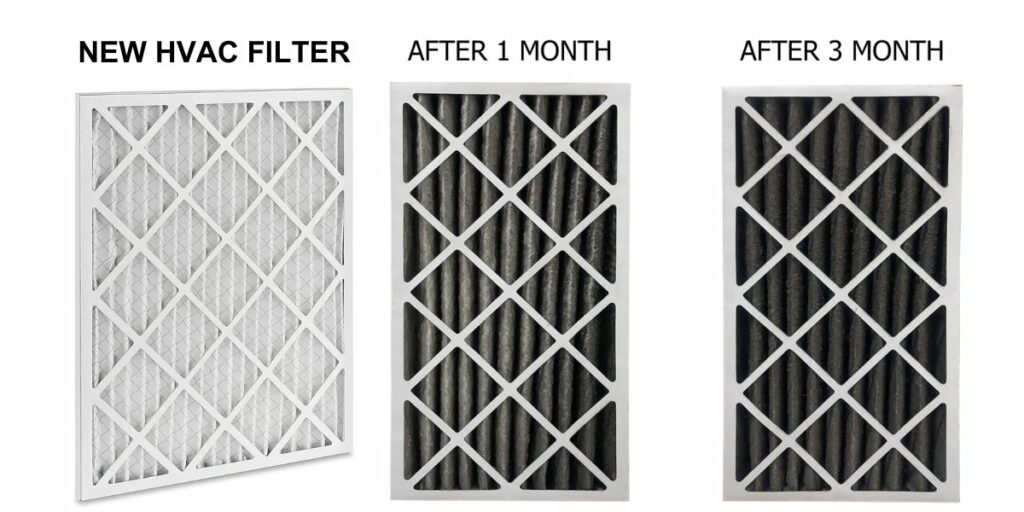When you notice your HVAC filter turning black, it’s understandable to feel a mix of concern and confusion. This unexpected sight might initially seem alarming, but it’s a sign that warrants attention, not panic. Let’s dive into the reasons behind a black HVAC filter and outline practical steps to address and prevent it, ensuring your home remains a safe, comfortable haven.

Common Causes of Black HVAC Filter
Encountering a black HVAC filter can be a startling discovery. This phenomenon is more than just a visual issue; it’s a signal from your HVAC system that something’s amiss. However, the reasons behind this discoloration vary, ranging from relatively harmless to signs of a more significant underlying problem. Understanding these causes is the first step towards a solution.
Soot
Soot accumulation is a frequent cause of black HVAC filters. This fine black powder can seem troubling, but it’s often a sign your filter is effectively capturing airborne particles. Sources of soot within your home include everyday items like candles, especially those with long wicks, and appliances such as a gas water heater with an improperly adjusted flame.
To mitigate soot buildup, regular maintenance of these items is crucial. Trimming candle wicks and ensuring your appliances function correctly can significantly reduce soot production.
Mold
A more concerning cause of filter blackening is mold growth, specifically black mold. Unlike soot, mold presents a health hazard, thriving in moist conditions often found in HVAC systems with poor condensation drainage.
Recognizing mold on your filter, characterized by a slimy texture and dampness, should prompt immediate action. Due to the health risks associated with mold, professional assessment, and removal are necessary to address the issue safely.
Clogged Filters
A severely clogged filter might be the issue in cases where soot or mold is not to blame. This scenario underscores the importance of regular filter maintenance for both the efficiency of your HVAC system and indoor air quality.
A clean filter is essential for system performance and safeguarding your health against pollutants and allergens.
How to Prevent Black Air Filter
Maintaining a clean air filter is not a challenging task. Yet, it plays a pivotal role in the health of your HVAC system and indoor environment. Let’s explore proactive steps to prevent your filter from turning black, ensuring it remains effective in its crucial role.
Regular HVAC Maintenance
Annual professional maintenance is foundational to HVAC care, offering early detection and prevention of issues that could lead to filter blackening. This preventive measure can avert potential soot and mold problems before they escalate.
Filter Replacement
Adhering to a regular filter replacement schedule, typically every 30 to 90 days, is essential. This frequency should be adjusted based on specific factors such as pet ownership or household allergies, ensuring your indoor air remains clean and healthy.
How often should you replace your HVAC Filter?
The frequency of filter replacement is not a one-size-fits-all matter. It varies based on the type of furnace and filter, living conditions, and specific household needs. While the general recommendation is at least once a year, factors such as filter quality and environmental conditions may necessitate more frequent changes.
Humidity Control
Keeping indoor humidity levels in check, ideally between 30% and 50%, can significantly prevent mold growth. Tools like hygrometers help monitor these levels, creating a mold-resistant environment.
Mindful Home Practices
Simple lifestyle adjustments can make a notable difference, like opting for less soot-producing candles and ensuring appliances are well-maintained. These mindful practices contribute to reducing soot and other particulates in your home.
Quality Air Filters
Investing in high-quality air filters with a higher MERV rating is wise. These filters are more efficient at trapping smaller particles, preventing them from blackening and improving overall air quality.
Ensuring Proper Ventilation
A well-ventilated home, with unobstructed vents and exhausts, supports healthy air circulation, reducing the chances of filter blackening due to pollutants or moisture.
The Bottom Line
Discovering a black HVAC filter is a call to action, urging you to assess and address the underlying causes. Understanding these issues enables you to take corrective measures, whether it’s soot, mold, or clogged filters. Through regular maintenance, mindful practices, and a commitment to air quality, you can ensure your HVAC system operates efficiently, keeping your indoor air clean and your living environment healthy. Remember, a proactive approach to HVAC care protects your system and enhances your home’s comfort and safety.






